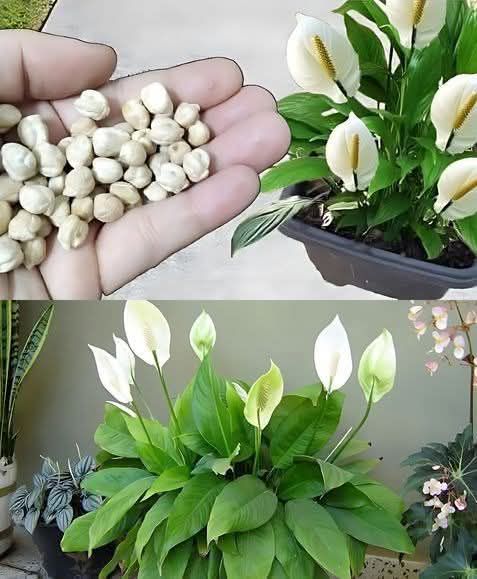This Is Gold for Your Plants to Grow: One Cup Is Enough to Make Many Flowers Bloom
Introduction
Are you looking for a natural, budget-friendly solution to help your plants flourish and burst into bloom? The answer might be hiding in your kitchen pantry: chickpeas. Often celebrated for their nutritional value in human diets, chickpeas also hold a treasure trove of benefits for plants. When properly prepared, just one cup of chickpea-based fertilizer can stimulate remarkable growth and vibrant flowering in a wide variety of plants.
This article will delve into the nutritious properties of chickpeas, explore the benefits of using them as plant fertilizer, provide a step-by-step guide to preparing chickpea fertilizer, and explain why this method is both economical and ecological. Read on to discover how a humble legume can become plant gold in your garden.
Nutritious Properties of Chickpeas
Chickpeas, also known as garbanzo beans, are more than just a superfood for humans—they’re powerhouses of plant nutrition. Here’s what makes chickpeas incredibly beneficial for plant growth:
- Potassium (K): Vital for flower and fruit development.
- Magnesium (Mg): Supports chlorophyll production and photosynthesis.
- Phosphorus (P): Promotes strong root systems and seed formation.
- Nitrogen (N): Essential for lush, green foliage and overall plant vigor.
- Selenium (Se): Enhances plant resistance to environmental stress.
- Boron (B): Supports cell wall strength and flower fertility.
These elements are crucial for maintaining balanced soil health, and they play a significant role in helping plants grow stronger, healthier, and more vibrant.
Benefits of Using Chickpeas for Plants
Using chickpeas as fertilizer isn’t just a trend—it’s a scientifically backed, time-tested method to rejuvenate plants. Here are the top benefits:
1. Revitalizes Tired Plants
If your houseplants or garden blooms are looking dull or stunted, chickpea fertilizer can give them a much-needed boost. The infusion of natural minerals revives their growth potential.
2. Promotes Lush Flowering
The combination of potassium, phosphorus, and boron in chickpeas helps to trigger flowering, encouraging your plants to bloom more often and more abundantly.
3. Supports Healthy Foliage
Nitrogen and magnesium contribute to rich, green foliage, making your plants appear healthier and more vibrant.
4. Boosts Soil Health
Chickpeas break down into organic matter that nourishes the soil, enhancing microbial activity and improving its overall structure.
5. Safe and Non-Toxic
Unlike chemical fertilizers, chickpea fertilizer is 100% natural, meaning it’s safe for edible plants, pets, and the environment.
Preparation of Fertilizer Made from Chickpeas
Making chickpea fertilizer is incredibly simple and requires only basic kitchen supplies. Follow this easy method to create your own batch of natural plant food:
Ingredients:
- 100 grams of dried or canned chickpeas
- 1 liter of water
Instructions:
Step 1: Boil Place 100 grams of chickpeas in 1 liter of water. Boil for about 10 minutes. This process extracts the vital nutrients into the water.
Step 2: Filter Once boiled, allow the mixture to cool slightly. Then filter out the chickpeas, keeping only the nutrient-rich water.
Step 3: Cool and Store Let the liquid cool completely. You can store it in a sealed container in the refrigerator for up to 1 week.
Step 4: Apply Use 1 cup of this filtered solution per plant. Simply water your plants at the base as you would normally do.
Frequency: Apply every 7–10 days for best results.
Economical and Ecological
One of the most attractive features of chickpea fertilizer is its cost-effectiveness and eco-friendliness. Here’s why:
- Low-cost: Chickpeas are inexpensive and often already available in most households.
- No harmful chemicals: Unlike synthetic fertilizers, this method contains zero toxic substances that could harm your plants or pollute the environment.
- Sustainable: Utilizing kitchen scraps and common foods for gardening purposes is a key aspect of sustainable living.
- Zero waste: You can even reuse the leftover chickpeas in compost or cooking!
Final Tips for Maximum Results
To make the most of your chickpea fertilizer, keep the following tips in mind:
- Use consistently: Apply regularly (weekly or bi-weekly) to maintain soil nutrient levels.
- Pair with compost: Combine chickpea fertilizer with organic compost for an even richer feeding experience.
- Test on one plant first: If you’re unsure how a specific plant will react, test the fertilizer on one plant before applying to all.
- Use filtered water if possible: This reduces the risk of chlorine interfering with the microbial health of your soil.
Conclusion
When it comes to promoting plant growth, few things are as affordable, effective, and natural as chickpea-based fertilizer. Just one cup of this simple solution is enough to transform your plants, triggering lush foliage, vibrant flowers, and stronger roots. It’s a small change with a big impact, offering a sustainable way to enhance your green space.
So the next time you’re boiling chickpeas for a meal, remember: you’re not just cooking for yourself—you’re also brewing liquid gold for your plants.
